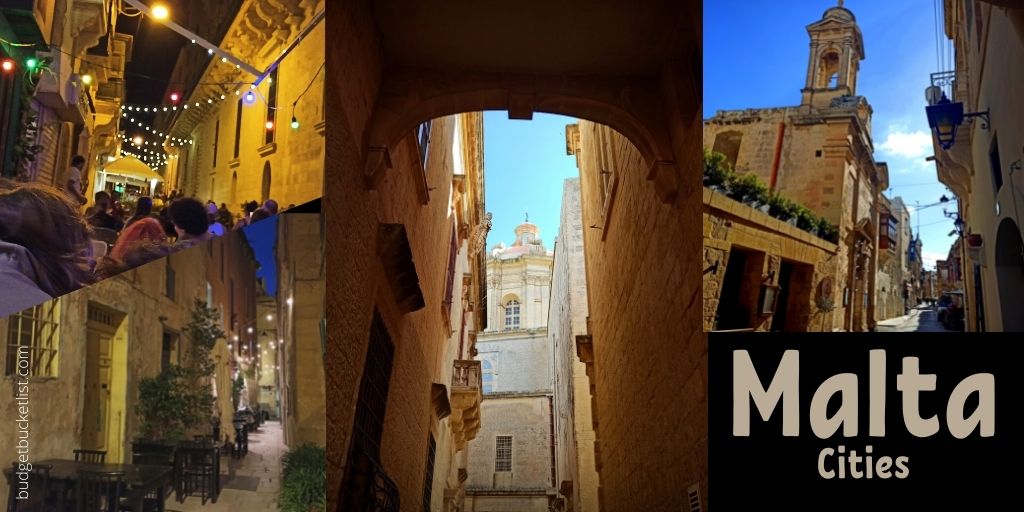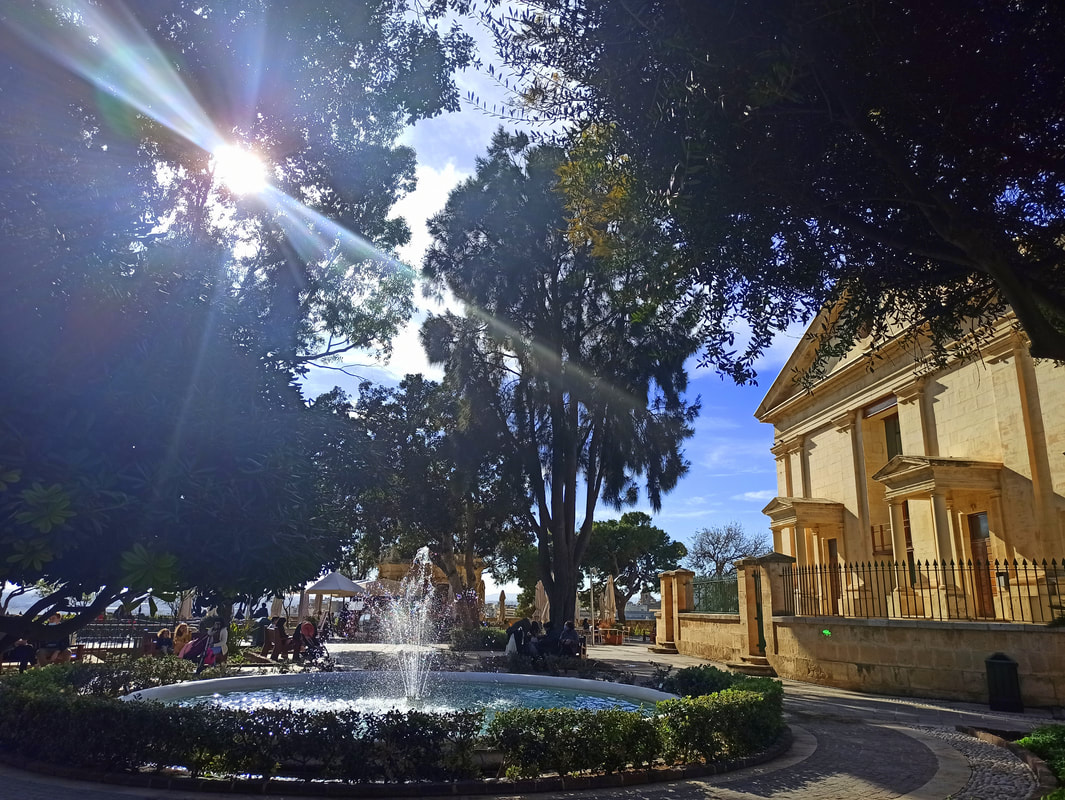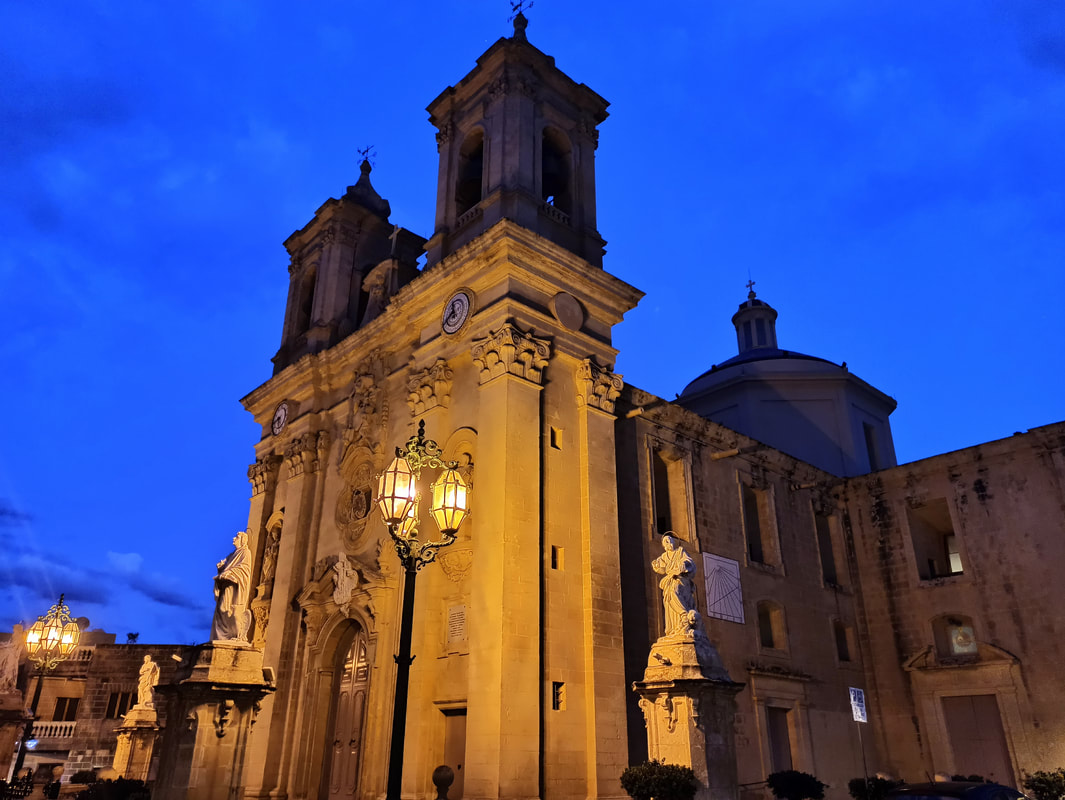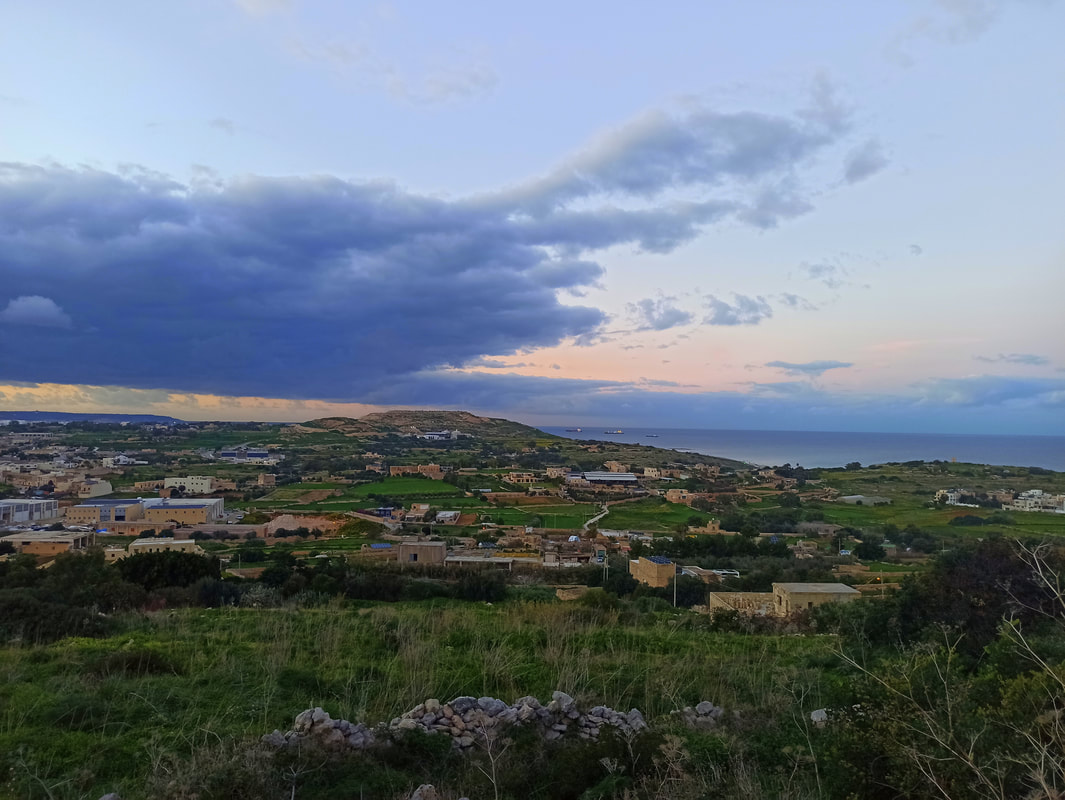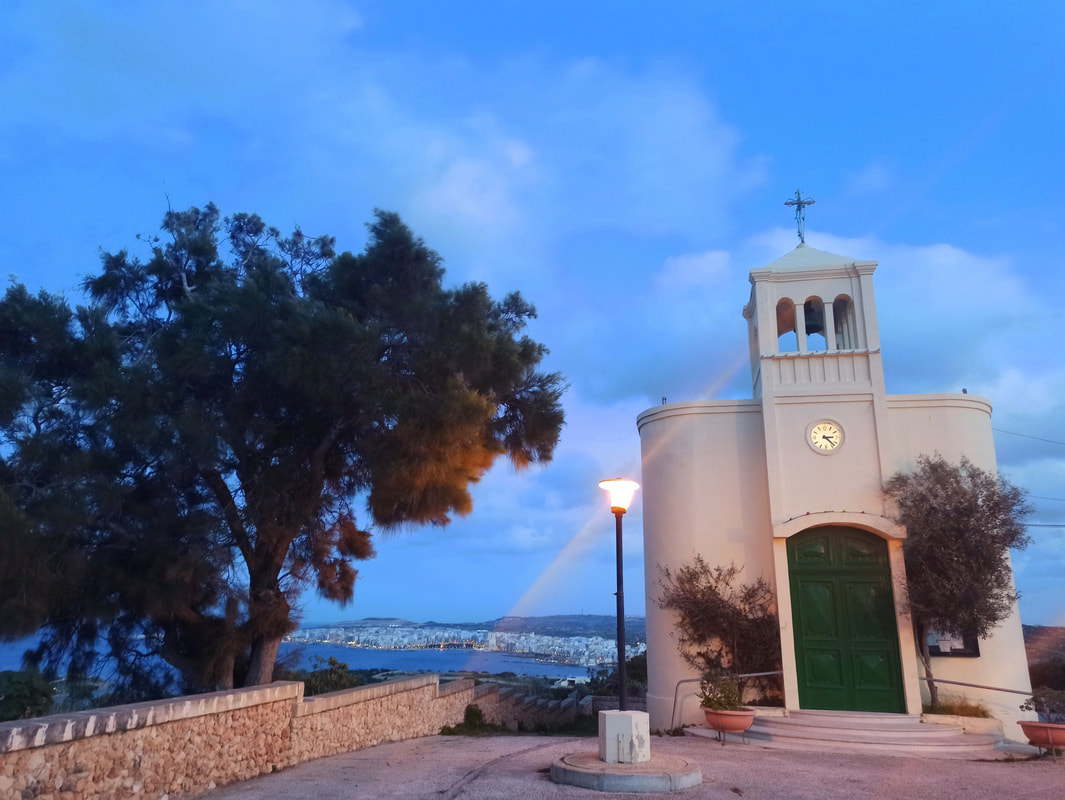Malta Cities
For budget tips & compact place-specific travel info... Download my FREE Budget Fact Sheets. You're welcome.
| Download Steph's MALTA Quick Budget Fact Sheet | |
| File Size: | 302 kb |
| File Type: | |
I write this article with you, an upcoming Malta-visitor, in mind. Why? Because most of your fellow travelers make a mistake when organizing their Mediterranean island-trip over here, without realizing they do. I didn’t know either, back then. Without thinking I would have booked my accommodation in St. Julian’s, Sliema or Gzira, as that’s what everyone does and where most lodging options are located… so there must be a reason for it, right? Right. There might be, but during my 7 months stay in Malta I couldn’t solve that mystery, other than that perhaps A) People didn’t know in advance and during their short holiday didn’t bother to look much further than that, so this is what Malta is now for them – which is sad; B) People didn’t know in advance, but as it was already booked and paid for now count their losses and just explore the real Malta on daytrips; C) People nowadays actually like modern, cheaply erected buildings with zero local character, randomly chucked into a polluted, chaotic environment like a poor-connecting Tetris-construction.
If you don’t belong to the last category and don’t want to belong to the first two, keep reading: I listed the most characteristic, local, and aesthetically pleasing cities for you, to stay in or explore during your Malta holiday:
Cities of Malta (Budget Bucket List Favorites)
Obvious eyecatchers and hidden gems
If you don’t belong to the last category and don’t want to belong to the first two, keep reading: I listed the most characteristic, local, and aesthetically pleasing cities for you, to stay in or explore during your Malta holiday:
Cities of Malta (Budget Bucket List Favorites)
Obvious eyecatchers and hidden gems
* Take into account: Malta in its entirety (the 3 islands included) is 316 km², compared to for example Mexico City of 1,485 km²… The entire country could basically be considered 1 big city, while everything they consider here as a town or city is actually a district. Nevertheless, in every single Maltese “city” or village, the sense of identity is strong, and they even have different accents, histories, and stereotyped citizens. Island life!
The Three Cities
Let’s kick off with three in one go: il-Kottonera, in English translated as The Three Cities. Included in the mighty three are Vittoriosa, Bormla and Isla… better known by their English names: Birgu, Cospicua and Senglea. This is the ultimate location to truly live Maltese history, even by simply strolling through the little backstreets and swirling alleys, trying to take it all in.
The oldest of the three Birgu was originally settled by the Phoenicians, and properly flourished during the reign of the Order of the Saint John. It was originally chosen as the capital city of Malta (after Mdina). Senglea was subsequently built on the L’Isola Peninsula and enriched with the Saint Michael Fort, while in Birgu Fort Saint Angelo was erected. The existing town Bormla (Burmula in Punic) became part of the fortifications under the name Città Cospicua (as it was higher up and therefore standing out: conspicuous). This happened during the reign of Grandmaster Cotoner, in an attempt to protect the harbour and Valletta from possible attacks by the Ottomans. These defence works came of good use during the famous Great Siege of Malta in 1565, when the Ottoman Empire indeed arrived to conquer Malta. The island was specifically interesting as the most strategic point in the Mediterranean, especially in the bigger macro perspective of a power play between Islam and Christianity. The Knights of St. John were victorious, and the Ottomans eventually retreated after a sequence of epic battles, damaging their image in Europe of being an invincible force. Only after the Siege, Valletta was built, which later became the new capital. During WWII the Three Cities were heavily bombed by the Nazi Germans and Fascist Italians, and rebuilt in the 1950s and 1960s.
After the war ended, the higher educated citizens moved out of the area and it became populated by the lower working class, where illiteracy and unemployment were common. Therefore, you’ll see the Maltese still frowning their eyebrows nowadays when you say you live / stay in the Three Cities. However, this is an inaccurate and expired stereotype, as in the 1990s regeneration projects restored the image by establishing several museums and a university in the area, attracting a different crowd. Nowadays, the area is considered rather classy and high end (although truth told: I think working class people are way more fun than the snobs - and why look down on anyone anyway?). My home in Malta!
Sights: Fort Saint Angelo, Fort Saint Michael, Gardjola Gardens, Maritime Museum, Inquisitor’s Palace, Marina, roaming in the little streets and alleys. The best swimming spot is in front of Fort Saint Angelo, reached by a small staircase on the side. While here, also visit Kalkara.
The Three Cities
Let’s kick off with three in one go: il-Kottonera, in English translated as The Three Cities. Included in the mighty three are Vittoriosa, Bormla and Isla… better known by their English names: Birgu, Cospicua and Senglea. This is the ultimate location to truly live Maltese history, even by simply strolling through the little backstreets and swirling alleys, trying to take it all in.
The oldest of the three Birgu was originally settled by the Phoenicians, and properly flourished during the reign of the Order of the Saint John. It was originally chosen as the capital city of Malta (after Mdina). Senglea was subsequently built on the L’Isola Peninsula and enriched with the Saint Michael Fort, while in Birgu Fort Saint Angelo was erected. The existing town Bormla (Burmula in Punic) became part of the fortifications under the name Città Cospicua (as it was higher up and therefore standing out: conspicuous). This happened during the reign of Grandmaster Cotoner, in an attempt to protect the harbour and Valletta from possible attacks by the Ottomans. These defence works came of good use during the famous Great Siege of Malta in 1565, when the Ottoman Empire indeed arrived to conquer Malta. The island was specifically interesting as the most strategic point in the Mediterranean, especially in the bigger macro perspective of a power play between Islam and Christianity. The Knights of St. John were victorious, and the Ottomans eventually retreated after a sequence of epic battles, damaging their image in Europe of being an invincible force. Only after the Siege, Valletta was built, which later became the new capital. During WWII the Three Cities were heavily bombed by the Nazi Germans and Fascist Italians, and rebuilt in the 1950s and 1960s.
After the war ended, the higher educated citizens moved out of the area and it became populated by the lower working class, where illiteracy and unemployment were common. Therefore, you’ll see the Maltese still frowning their eyebrows nowadays when you say you live / stay in the Three Cities. However, this is an inaccurate and expired stereotype, as in the 1990s regeneration projects restored the image by establishing several museums and a university in the area, attracting a different crowd. Nowadays, the area is considered rather classy and high end (although truth told: I think working class people are way more fun than the snobs - and why look down on anyone anyway?). My home in Malta!
Sights: Fort Saint Angelo, Fort Saint Michael, Gardjola Gardens, Maritime Museum, Inquisitor’s Palace, Marina, roaming in the little streets and alleys. The best swimming spot is in front of Fort Saint Angelo, reached by a small staircase on the side. While here, also visit Kalkara.
Too busy to read now? No problem, save it for later!
Save on Get Pocket | Save in Browser Bookmarks| Save on Instapaper
Save on Get Pocket | Save in Browser Bookmarks| Save on Instapaper
Għargħur
You have probably not heard of this one, nor met many travelers who made it out there. That makes it even better, as it means you will have this authentic Maltese gem all to yourself. Scenically located on a hilltop tucked in between two valleys, this little town offers panoramic views over the entire miniature country (at only 133m, imagine that). Artifacts indicate the existence of the town since around 1419, although the area (where they even spoke in an own separate dialect) was severely de-populated due to continuous pirate attacks. That might be the most eventful period since, as now it’s mainly a haven of relaxation and tranquillity. This place properly won me over.
Sights: Top of the World Look-out Point, Church of Saint Bartholomew, Cru Wine Cellar, Historical Center.
You have probably not heard of this one, nor met many travelers who made it out there. That makes it even better, as it means you will have this authentic Maltese gem all to yourself. Scenically located on a hilltop tucked in between two valleys, this little town offers panoramic views over the entire miniature country (at only 133m, imagine that). Artifacts indicate the existence of the town since around 1419, although the area (where they even spoke in an own separate dialect) was severely de-populated due to continuous pirate attacks. That might be the most eventful period since, as now it’s mainly a haven of relaxation and tranquillity. This place properly won me over.
Sights: Top of the World Look-out Point, Church of Saint Bartholomew, Cru Wine Cellar, Historical Center.
Selmun
Another virtually unknown spot is Selmun, a place I once pleasantly stumbled upon during one of my many Malta hikes. There’s hardly anything there, which is exactly the draw on the tumultuous island of Malta. No noise, no construction work, no blaring motorways… just a tiny chapel, a quiet restaurant, and some historical houses here and there. Breathe in, breathe out… you’re away from all the madness.
Sights: Selmun Palace, Selmun Chapel.
Another virtually unknown spot is Selmun, a place I once pleasantly stumbled upon during one of my many Malta hikes. There’s hardly anything there, which is exactly the draw on the tumultuous island of Malta. No noise, no construction work, no blaring motorways… just a tiny chapel, a quiet restaurant, and some historical houses here and there. Breathe in, breathe out… you’re away from all the madness.
Sights: Selmun Palace, Selmun Chapel.
Marsaxlokk
Nothing screams “traditional fisherman’s village” like Marsaxlokk does (from the Arabic word “marsa” which means port, and the Maltese word for south-east: “xlokk”). It was used as an important harbour by the Phoenicians, Carthaginians, and Romans, and originally formed a part of the now hardly noteworthy town of Zejtun. When in the late 19th century Zejtun’s fishermen grew tired of commuting up and down the shore, they decided to settle down at the waters, allowing Marsaxlokk to flourish as a separate entity. Nowadays, the hustle and bustle of the fisherfolk as well as the Sunday Fish Market is a main draw to both tourists and locals alike. Take a little boat trip, treat yourself on some fresh caught lunch, relax on the small beach, or hike the stunning coastal trail towards Marsaskala (which, by the way, is quite a pleasant town on its own and worth a visit).
Sights: Delimara Light House (most southern point), Fort Delimara, St. Peter’s Pool, Marsaxlokk (Il-Kalanka) Beach, Hiking Trails, Xrobb I-Ghagin Nature Park.
Nothing screams “traditional fisherman’s village” like Marsaxlokk does (from the Arabic word “marsa” which means port, and the Maltese word for south-east: “xlokk”). It was used as an important harbour by the Phoenicians, Carthaginians, and Romans, and originally formed a part of the now hardly noteworthy town of Zejtun. When in the late 19th century Zejtun’s fishermen grew tired of commuting up and down the shore, they decided to settle down at the waters, allowing Marsaxlokk to flourish as a separate entity. Nowadays, the hustle and bustle of the fisherfolk as well as the Sunday Fish Market is a main draw to both tourists and locals alike. Take a little boat trip, treat yourself on some fresh caught lunch, relax on the small beach, or hike the stunning coastal trail towards Marsaskala (which, by the way, is quite a pleasant town on its own and worth a visit).
Sights: Delimara Light House (most southern point), Fort Delimara, St. Peter’s Pool, Marsaxlokk (Il-Kalanka) Beach, Hiking Trails, Xrobb I-Ghagin Nature Park.
L -Armier
Talking about fishermen’s villages… L-Armier might not be as aesthetically pleasing as colorful Marsaxlokk (it actually looks a lot like a trailer park when sailing by it from the waters), but it somehow feels real. It is basically a collection of prior fisherman’s sheds turned into weekend houses, as basic as it could possibly get… but I’d consider myself quite lucky if my family had one. There are three beaches nearby: Nothing special, but they do the job. For a more active engagement one could consider kayaking and scuba-diving. In order to get a taste of the environment, you can spend a couple of days in Malta’s biggest wild-camp area called L-Aħrax Bay… although you’d be sharing that area with many Maltese family get-togethers marked by BBQ’s and loud music (and unfortunately: trash being left behind in alarming quantities). I’d like to point out the interesting but (due to the uneven surface) challenging hike past the Coral Lagoon sinkhole, which also offers fantastic views over both the island of Comino and Gozo.
Sights: Armier Bay Beach, Little Armier Beach / Tortuga Beach, White Tower Bay, L-Aħrax Bay, Coral Lagoon.
Talking about fishermen’s villages… L-Armier might not be as aesthetically pleasing as colorful Marsaxlokk (it actually looks a lot like a trailer park when sailing by it from the waters), but it somehow feels real. It is basically a collection of prior fisherman’s sheds turned into weekend houses, as basic as it could possibly get… but I’d consider myself quite lucky if my family had one. There are three beaches nearby: Nothing special, but they do the job. For a more active engagement one could consider kayaking and scuba-diving. In order to get a taste of the environment, you can spend a couple of days in Malta’s biggest wild-camp area called L-Aħrax Bay… although you’d be sharing that area with many Maltese family get-togethers marked by BBQ’s and loud music (and unfortunately: trash being left behind in alarming quantities). I’d like to point out the interesting but (due to the uneven surface) challenging hike past the Coral Lagoon sinkhole, which also offers fantastic views over both the island of Comino and Gozo.
Sights: Armier Bay Beach, Little Armier Beach / Tortuga Beach, White Tower Bay, L-Aħrax Bay, Coral Lagoon.
Mdina / Rabat
Yeah, you were probably wondering where this one was at, after seeing it mentioned on every possible blog or travel list. No worries, also Budget Bucket List agrees: Mdina is an absolute treasure, you’re talking to a Game of Thrones fan for f*ck’s sake (Mdina = King’s Landing). I can’t even count anymore how often I roamed the exact same streets knowing precisely what was awaiting me, but feeling that continuous need to “show” this place to yet another friend or acquaintance visiting me in Malta. This famous fortified city was actually founded in the 8th Century by the Phoenicians and renamed Melite by the Romans, to be eventually turned into Malta’s capital (until the Order of St. John handed that crown to Birgu). Nowadays, its flawless streets capturing the exact Maltese architecture (but in an overly clean and crisp manner) are a main tourist attraction, to be walked through in roughly 20 minutes. However, it could be considered a small, more polished patch of the bigger town of Rabat, which is worth the extension of the visit… somehow, I might like Rabat even more, presenting a more vulgar, rugged representation of the essence of Malta. I prefer to keep things real.
Sights: Mdina Cathedral & Museum, St. Paul’s Catacombs, Domus Romana, Mdina Gate, National Museum of Natural History.
Yeah, you were probably wondering where this one was at, after seeing it mentioned on every possible blog or travel list. No worries, also Budget Bucket List agrees: Mdina is an absolute treasure, you’re talking to a Game of Thrones fan for f*ck’s sake (Mdina = King’s Landing). I can’t even count anymore how often I roamed the exact same streets knowing precisely what was awaiting me, but feeling that continuous need to “show” this place to yet another friend or acquaintance visiting me in Malta. This famous fortified city was actually founded in the 8th Century by the Phoenicians and renamed Melite by the Romans, to be eventually turned into Malta’s capital (until the Order of St. John handed that crown to Birgu). Nowadays, its flawless streets capturing the exact Maltese architecture (but in an overly clean and crisp manner) are a main tourist attraction, to be walked through in roughly 20 minutes. However, it could be considered a small, more polished patch of the bigger town of Rabat, which is worth the extension of the visit… somehow, I might like Rabat even more, presenting a more vulgar, rugged representation of the essence of Malta. I prefer to keep things real.
Sights: Mdina Cathedral & Museum, St. Paul’s Catacombs, Domus Romana, Mdina Gate, National Museum of Natural History.
Mosta
Talking about getting down and dirty to a more realistic representation of what Malta means to me… Mosta! I really like Mosta! Not as brushed off and pretentious as Mdina or Valletta, but genuine and pleasantly unrefined, yet 100% Maltese. Undeniably, the main attraction is the remarkable Rotunda, modeled after the Pantheon of Rome. This cathedral takes much of its fame leaning on the “miracle” of a Nazi bomb plunging right through the (unsupported!) dome during mass, but failing to explode. Even though God condoned WWII and the entire Holocaust, he seemed to be kind enough to save some lives in Mosta: Wow, a true miracle! While at it, check out the bunkers under the Rotunda, for some confronting dive into recent history.
Sights: Rotunda, Ta’Bistra Catacombs, Chapel of St. Paul The Hermit, Fort Mosta, Mosta Bridge, Mosta Valley & Victoria Lines.
Talking about getting down and dirty to a more realistic representation of what Malta means to me… Mosta! I really like Mosta! Not as brushed off and pretentious as Mdina or Valletta, but genuine and pleasantly unrefined, yet 100% Maltese. Undeniably, the main attraction is the remarkable Rotunda, modeled after the Pantheon of Rome. This cathedral takes much of its fame leaning on the “miracle” of a Nazi bomb plunging right through the (unsupported!) dome during mass, but failing to explode. Even though God condoned WWII and the entire Holocaust, he seemed to be kind enough to save some lives in Mosta: Wow, a true miracle! While at it, check out the bunkers under the Rotunda, for some confronting dive into recent history.
Sights: Rotunda, Ta’Bistra Catacombs, Chapel of St. Paul The Hermit, Fort Mosta, Mosta Bridge, Mosta Valley & Victoria Lines.
Valletta
Of course, Valletta. After Mdina and Birgu the current capital, and honestly, quite rightfully so. Named after Jean Parisot de Valette, one of the Knights of St. John who succeeded in fighting off the Ottomans during the Great Siege of Malta, Valletta currently still shines off this glimmer of victory. Wide, fancy streets cropped into a network of fortifications, bastions and cavaliers form a rightful crown on the small, yet loud and vigorous island of Malta, fighting off anyone and anything that dare to underestimate it (a trait quite visible in its people until the day of today). Honestly, I tend to be skeptical about capital cities, as although they fill me with curiosity about the arts, fashion, and fast life, they simultaneously trigger a reluctancy to be confronted with the contamination and commotion that generally tend to form an inevitable part. Valletta, Europe’s smallest capital city, denies all of these drawbacks, and instead presents clean and classy streets, tied together by immaculate architecture. Well done, Jean!
Sights: Upper Barrakka Gardens & Saluting Battery, Lower Barrakka Gardens & Siege Bell War Memorial, Fort St. Elmo & National War Museum, MUZA, Grandmaster’s Palace, St. John’s Cathedral, Casa Rocca Piccola, Triton Fountain, National Museum of Archaeology, War HQ Tunnel, Parocca San Pawl Nawfragu, The Knights Hospitallers, Manoel Theatre, Toy Museum, Royal Armoury, Pjazza Teatru Rjal. There's a boat connection between Valletta and Cospicua/Bormla (Three Cities), for which you can use your Talinja Card. Private wooden boats leave from the Birgu waterfront.
Of course, Valletta. After Mdina and Birgu the current capital, and honestly, quite rightfully so. Named after Jean Parisot de Valette, one of the Knights of St. John who succeeded in fighting off the Ottomans during the Great Siege of Malta, Valletta currently still shines off this glimmer of victory. Wide, fancy streets cropped into a network of fortifications, bastions and cavaliers form a rightful crown on the small, yet loud and vigorous island of Malta, fighting off anyone and anything that dare to underestimate it (a trait quite visible in its people until the day of today). Honestly, I tend to be skeptical about capital cities, as although they fill me with curiosity about the arts, fashion, and fast life, they simultaneously trigger a reluctancy to be confronted with the contamination and commotion that generally tend to form an inevitable part. Valletta, Europe’s smallest capital city, denies all of these drawbacks, and instead presents clean and classy streets, tied together by immaculate architecture. Well done, Jean!
Sights: Upper Barrakka Gardens & Saluting Battery, Lower Barrakka Gardens & Siege Bell War Memorial, Fort St. Elmo & National War Museum, MUZA, Grandmaster’s Palace, St. John’s Cathedral, Casa Rocca Piccola, Triton Fountain, National Museum of Archaeology, War HQ Tunnel, Parocca San Pawl Nawfragu, The Knights Hospitallers, Manoel Theatre, Toy Museum, Royal Armoury, Pjazza Teatru Rjal. There's a boat connection between Valletta and Cospicua/Bormla (Three Cities), for which you can use your Talinja Card. Private wooden boats leave from the Birgu waterfront.
Safi / Zurrieq
There’s not much to do in Zurrieq and the adjacent Safi… just people living their lives. But isn’t that what we travel for as well, to see how people from other cultures than our own live their lives? To me, aimlessly wandering in between the cracked yellow walls, hollowed out to make place for a Maria or St. Georg statue, makes me feel like a reached the core of Malta. Even considering the fact that in just Zurrieq, which is only 10 km², there are 12 different chapels and churches, you know the Maltese spirit is hitting hard here. To me, Safi is what Mdina is in comparison to Rabat: slightly cleaner, more organized and with its bright white wind mill a tad more tourist-friendly.
Sights: Just a bunch of churches and a windmill.
There’s not much to do in Zurrieq and the adjacent Safi… just people living their lives. But isn’t that what we travel for as well, to see how people from other cultures than our own live their lives? To me, aimlessly wandering in between the cracked yellow walls, hollowed out to make place for a Maria or St. Georg statue, makes me feel like a reached the core of Malta. Even considering the fact that in just Zurrieq, which is only 10 km², there are 12 different chapels and churches, you know the Maltese spirit is hitting hard here. To me, Safi is what Mdina is in comparison to Rabat: slightly cleaner, more organized and with its bright white wind mill a tad more tourist-friendly.
Sights: Just a bunch of churches and a windmill.
Victoria (/Rabat - another Rabat… so let’s just stick with Victoria)
You might wonder why this is the first city in Gozo I mention. Well, that’s because the main draw of Gozo (to me) is that it’s hardly populated. You don’t go to Gozo to visit a city per se, you go there for a good hike and a refreshing diving experience. Nature flourishes there! Fair enough, there are a bunch of towns and villages, some of them pleasant (Xlendi), some not so much (Marsalforn)… but there’s one that demands a visit on its own: stunning Victoria, the capital of this specific island. Unlike the fancy glam and glory of Valletta, Victoria is a collective of swirling alleyways Malta is so famous for… teasing you at every curve and corner with fresh wonder to find out what new discoveries the next turn brings, while slowly losing track of any sense of direction. Needless to say, a visit to Gozo is per definition incomplete without including the Citadella, officially a Punic-Roman acropolis that triggered the growth of the city around it. Nowadays, it towers elegantly over the country’s greenest island and houses several museums and points of interest.
Sights: Citadella, Historical Center.
You might wonder why this is the first city in Gozo I mention. Well, that’s because the main draw of Gozo (to me) is that it’s hardly populated. You don’t go to Gozo to visit a city per se, you go there for a good hike and a refreshing diving experience. Nature flourishes there! Fair enough, there are a bunch of towns and villages, some of them pleasant (Xlendi), some not so much (Marsalforn)… but there’s one that demands a visit on its own: stunning Victoria, the capital of this specific island. Unlike the fancy glam and glory of Valletta, Victoria is a collective of swirling alleyways Malta is so famous for… teasing you at every curve and corner with fresh wonder to find out what new discoveries the next turn brings, while slowly losing track of any sense of direction. Needless to say, a visit to Gozo is per definition incomplete without including the Citadella, officially a Punic-Roman acropolis that triggered the growth of the city around it. Nowadays, it towers elegantly over the country’s greenest island and houses several museums and points of interest.
Sights: Citadella, Historical Center.
Not a fan: Sliema, St. Julian’s, Gzira, Msida, Floriana, Birkirkara, Birzebuggia, Luqa, Qormi, Xghajra, Marsalforn… The other towns you could say I perceive neutrally: Not a highlight to me, but with its own charm. I encourage you to go out and explore and form your own opinion.
In order to support the travelers’ community, I spend many hours per week to adequately document all information and advices for prospective visitors, accompanied by a (hopefully) entertaining insight into my personal observations and experiences. This service is and will remain free. However, if you voluntarily want to make a contribution and support my travels and thus the creation of new stories and information supply, here is the button you’re looking for:
Related:
- More Malta blogs: Malta's Hiking Guide & Malta's Sand Beaches
- Explore Cyprus: Check out the Cyprus Nature, Cyprus Top-5 Cities and the North Cyprus Blogs!
- Citytripping in Denmark's capital: Copenhagen
- Where modern meets classic: Vilnius, Lithuania
- A capital surrounded by scenic little villages: Lisbon, Portugal
- Get deep into Greece: Athens, Delphi, Arachova, Mount Parnassos NP, Epirus, Meteora, Thessaloniki & Volos
- Archeological treasures, UNESCO sights and Greece's roughest nature: Explore the Peloponnese!
- Spanish citytrips: Barcelona, Malaga & Sevilla
- The modern delights of Frankfurt am Main, Germany
- The smoggy capital of Malaysia: Kuala Lumpur
- Getting comfy in the Korean big smokes: Busan and Seoul
- Discover Romania's enjoyable cities: Bucharest, Brasov and Cluj Napoca
- Vibrant cities in Mexico: Merida, Oaxaca, Puebla, Queretaro, San Cristobal de las Casas
- Capital cities in Central America: Panama City, San Jose, San Salvador, Managua, Belmopan
- More Malta blogs: Malta's Hiking Guide & Malta's Sand Beaches
- Explore Cyprus: Check out the Cyprus Nature, Cyprus Top-5 Cities and the North Cyprus Blogs!
- Citytripping in Denmark's capital: Copenhagen
- Where modern meets classic: Vilnius, Lithuania
- A capital surrounded by scenic little villages: Lisbon, Portugal
- Get deep into Greece: Athens, Delphi, Arachova, Mount Parnassos NP, Epirus, Meteora, Thessaloniki & Volos
- Archeological treasures, UNESCO sights and Greece's roughest nature: Explore the Peloponnese!
- Spanish citytrips: Barcelona, Malaga & Sevilla
- The modern delights of Frankfurt am Main, Germany
- The smoggy capital of Malaysia: Kuala Lumpur
- Getting comfy in the Korean big smokes: Busan and Seoul
- Discover Romania's enjoyable cities: Bucharest, Brasov and Cluj Napoca
- Vibrant cities in Mexico: Merida, Oaxaca, Puebla, Queretaro, San Cristobal de las Casas
- Capital cities in Central America: Panama City, San Jose, San Salvador, Managua, Belmopan
